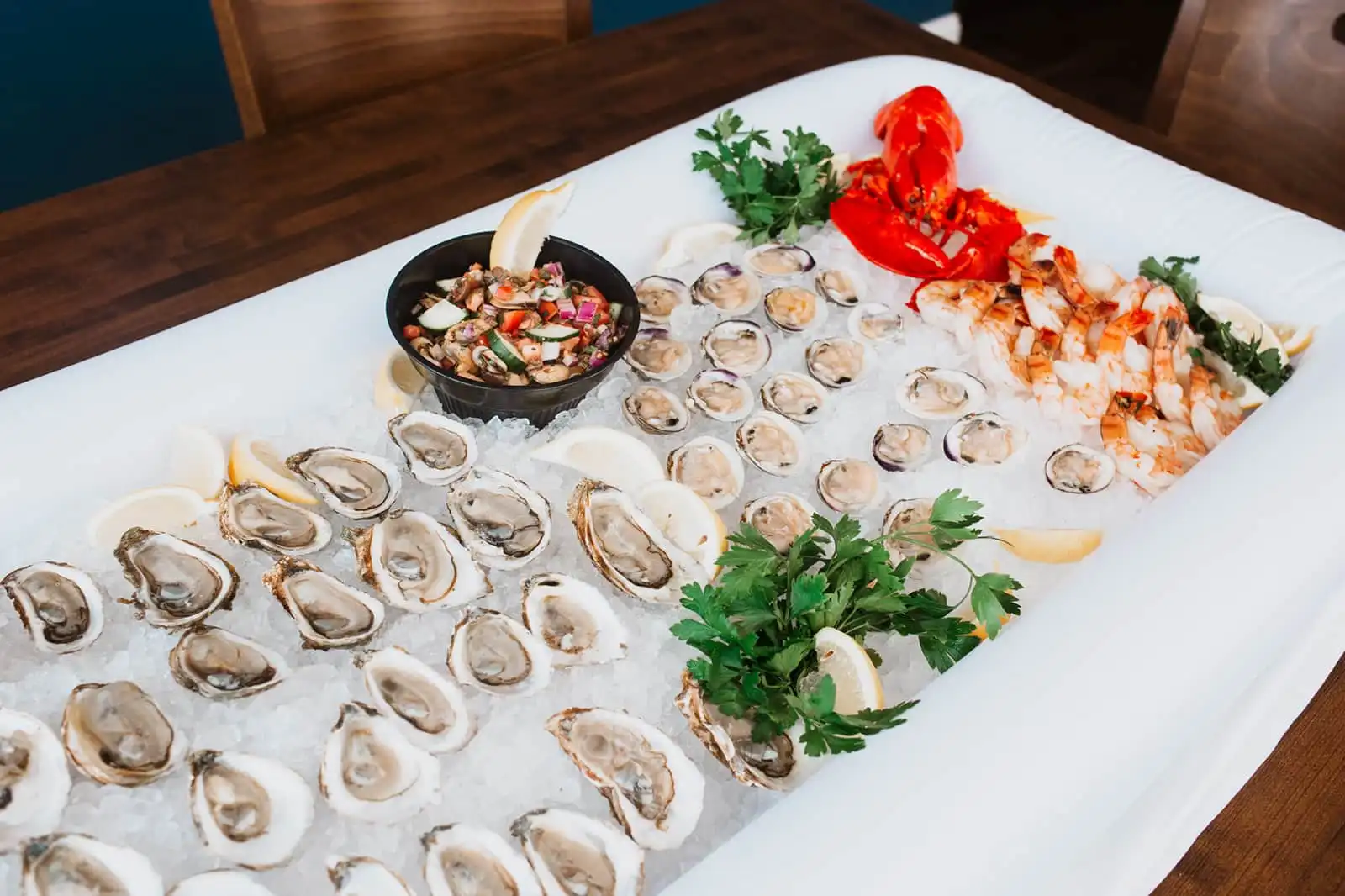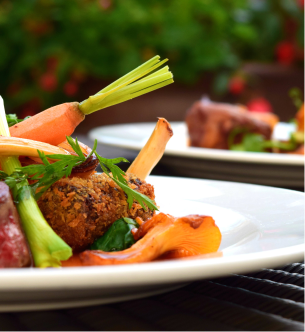Raw Bar Experiences: The Perfect Blend of Food, Fun, and Visual Appeal
30 seconds summary
- A raw bar experience blends fresh seafood, social interaction, and stunning visual appeal, making it a memorable centerpiece for any event. Whether at a seaside restaurant or an oyster bar wedding, it offers a unique, interactive dining experience where guests enjoy oysters, clams, shrimp, and more, often paired with refreshing drinks.
- The presentation is as much an art form as the food itself, with ice displays and vibrant garnishes heightening the sensory enjoyment.
- Raw bars create an atmosphere of luxury, fun, and indulgence, perfect for celebrations, making them a timeless favorite.
Introduction
There are few culinary experiences as immersive, celebratory, and visually striking as a raw bar. Whether perched at a seaside restaurant, attending a grand wedding reception, or enjoying a chic corporate event, the raw bar has a unique ability to capture attention, spark conversations, and satisfy cravings all at once. Unlike many other dining setups, raw bars combine food, fun, and artistry in equal measure.
From piles of ice shimmering under glistening oysters, to the careful placement of colorful garnishes, to the laughter of guests as they sip cocktails and sample delicacies, a raw bar is more than a dining option, it’s a statement of taste, atmosphere, and style. This article will explore the evolution, cultural significance, setup, and experiential value of raw bars, showing how they serve as the perfect blend of food, fun, and visual appeal.
Chapter 1: The Origins and Evolution of Raw Bars
Raw bars trace their lineage back to coastal communities where seafood was freshly harvested and consumed on the spot. Ancient fishing villages often held communal gatherings where clams, oysters, and crustaceans were shared directly after harvesting, sometimes eaten raw with little more than a splash of seawater.
As trade expanded, so did the appreciation for fresh seafood. By the 19th century, oyster houses and seafood taverns in cities like New York, Boston, and London introduced the concept of presenting seafood on ice in public dining establishments. Oysters were famously affordable then, often enjoyed by both working-class dockworkers and upper-class elites.
Over time, the raw bar evolved into a cultural symbol of freshness, indulgence, and sophistication. Today, it remains a staple of luxury dining, yet also appeals to casual food lovers. Its duality, accessible yet extravagant, makes it endlessly versatile.
Chapter 2: The Visual Theater of the Raw Bar
At its core, a raw bar is performance art. Guests don’t just eat; they watch as chefs shuck oysters, slice sashimi, and arrange seafood on dramatic displays of ice, shells, and decorative elements. The presentation is carefully orchestrated for visual impact.
Imagine a tiered tower of oysters, clams, mussels, and crab legs, accented with lemon wedges, seaweed, and edible flowers. The icy base sparkles under soft lighting, while steam from dry ice may curl upward like ocean mist. Every detail is intentional, designed to stimulate not just the palate but also the eyes.
This visual appeal contributes to the raw bar’s popularity in social media culture. Photos of carefully arranged oysters or lobster tails are endlessly shareable, turning private experiences into collective appreciation online. The raw bar is, in many ways, a ready-made Instagram moment.
Chapter 3: The Social Side of Raw Bars
Food brings people together, and the raw bar amplifies this truth. Unlike plated meals, where guests eat in relative isolation, a raw bar invites mingling. People gather around the display, strike up conversations with the shucker, and bond over shared culinary adventures.
The setup naturally encourages interaction. Guests may ask each other for recommendations: “Have you tried the scallop crudo yet?” or share their delight at discovering a new flavor combination. In event settings, this dynamic transforms a raw bar into a social hub, making it ideal for weddings, parties, and networking gatherings.
Alcohol often complements the seafood, with champagne, white wine, or craft cocktails flowing freely. The pairing of bubbly drinks and briny delicacies creates a festive, celebratory energy.
Chapter 4: Raw Bars at Weddings and Events
One of the most striking places to encounter a raw bar today is at a wedding reception. Couples looking to dazzle their guests often choose raw bar stations as part of their catering. This not only elevates the culinary offering but also adds a theatrical, luxurious element to the event.
An Oyster bar wedding is a particularly memorable experience. Guests are greeted with trays of freshly shucked oysters, each paired with unique toppings, from classic mignonette to inventive spicy ponzu sauces. The oyster bar becomes more than a meal; it becomes a memorable highlight of the celebration, reflecting the couple’s sophistication and love for hospitality.
In corporate events, raw bars serve a similar role: signaling prestige, attention to detail, and creativity. They stand apart from the predictable buffet or plated meal, offering something interactive and unexpected.
Chapter 5: Components of a Raw Bar
A true raw bar is more than just oysters. While oysters may be the crown jewel, the complete experience includes a variety of fresh, chilled, or lightly cured items. Common elements include:
- Oysters: The star attraction, often sourced from different regions to showcase a variety of flavor profiles.
- Clams: Served raw or steamed, offering a slightly firmer texture and sweet, briny flavor.
- Shrimp cocktail: A timeless favorite, chilled and paired with cocktail sauce or aioli.
- Crab legs: Snow crab or king crab, served cracked for easy enjoyment.
- Lobster: Lobster tails or claws, displayed prominently as a sign of indulgence.
- Sashimi: Thinly sliced raw fish such as tuna or salmon, adding a Japanese-inspired touch.
- Ceviche: Fresh fish cured in citrus juice, layered with herbs, onions, and peppers for brightness.
- Condiments: Lemon wedges, cocktail sauce, horseradish, hot sauce, flavored vinegars, and herbs.
These items are not only chosen for taste but also for their contribution to visual variety, different colors, textures, and shapes combine to create edible art.
Chapter 6: The Science of Freshness
The success of a raw bar depends heavily on the perception of freshness. Seafood, more than almost any other category, must be impeccably fresh to be safe and enjoyable. Guests expect the coldest ice, the cleanest shells, and the briniest flavors.
Chefs and event planners take this responsibility seriously. They work with trusted suppliers, often sourcing seafood from sustainable farms or fisheries. Transportation is carefully managed, with strict cold-chain protocols ensuring that the seafood is never compromised.
Freshness is also communicated visually. A clean, sparkling raw bar reassures guests that the seafood is safe and premium. The glistening ice, polished shells, and bright garnishes all play a role in this perception.
Chapter 7: Pairing Drinks with the Raw Bar
No raw bar experience is complete without drinks. The pairing of beverages with raw seafood is both science and art.
- Champagne and sparkling wine: The effervescence cuts through the richness of oysters and enhances their briny notes.
- Crisp white wines: Sauvignon Blanc, Muscadet, or Albariño are classic choices that complement seafood.
- Cocktails: A gin and tonic with cucumber, a dry martini, or a vodka-based Bloody Mary pair beautifully with chilled shellfish.
- Craft beers: Light lagers, pilsners, or wheat beers provide a refreshing counterbalance.
The right pairing heightens the fun, making guests feel like they’re indulging in a curated, elevated experience.
Chapter 8: Raw Bars Around the World
While raw bars are strongly associated with Western dining, variations exist globally:
- Japan: Sushi and sashimi bars share many qualities with raw bars, emphasizing freshness and knife skills.
- Peru: Ceviche stations are a staple of celebrations, with vibrant, citrusy seafood preparations.
- France: Plateau de fruits de mer, tiered towers of oysters, shrimp, and lobster, represent the French equivalent of a raw bar.
- Nordic countries: Smørrebrød and seafood buffets highlight cold-water delicacies like herring, salmon, and roe.
These cultural variations demonstrate the universal appeal of raw seafood as both nourishment and spectacle.
Chapter 9: The Fun Factor
Why are raw bars so enjoyable? Beyond the flavors, raw bars create excitement. Guests often step out of their comfort zone to try something new, whether it’s their first oyster, a unique ceviche, or a novel garnish.
The interactivity of watching seafood being shucked or prepared adds entertainment. The experience feels less like dining and more like attending a live performance, where the chef or shucker is both artisan and showman.
In addition, the sheer abundance of a raw bar, piles of seafood, glittering ice, endless garnishes, creates a feeling of abundance and indulgence that sparks joy.
Chapter 10: The Perfect Blend
When considering food, fun, and visual appeal, the raw bar stands in a league of its own. Few dining experiences balance all three so effortlessly:
- Food: Fresh, luxurious, and varied.
- Fun: Interactive, social, and adventurous.
- Visual Appeal: A show-stopping centerpiece that doubles as décor.
This balance explains why raw bars have transcended their origins to become global symbols of celebration and sophistication. Whether at a seaside shack or a glamorous black-tie event, the raw bar delivers an unforgettable experience.
Chapter 10: Future Trends in Raw Bar Experiences
As dining continues to evolve, raw bars are adapting too. Some emerging trends include:
- Sustainability: More emphasis on responsibly sourced seafood and eco-friendly displays.
- Fusion flavors: Creative condiments inspired by global cuisines, such as kimchi mignonette or yuzu ponzu.
- Interactive education: Chefs offering mini-lessons on oyster regions or fish varieties.
- Vegan raw bars: For inclusivity, some events offer plant-based alternatives styled like seafood towers.
These innovations ensure that raw bars remain fresh, relevant, and exciting for new generations.
Conclusion
Raw bars embody the magic of dining as an experience rather than a necessity. They bring together exquisite food, artistic presentation, and a sense of joy that transforms meals into memories. Whether you encounter one at a seaside bistro, a chic rooftop party, or an oyster bar wedding, the raw bar always delivers something extraordinary.
In a world where people seek not just to eat but to connect, celebrate, and share, raw bars remain timeless. They are at once ancient and modern, humble and luxurious, intimate and spectacular. Above all, they are the perfect blend of food, fun, and visual appeal, a feast for all senses.






One response to “Raw Bar Experiences: The Perfect Blend of Food, Fun, and Visual Appeal”
Very helpful explanation — I learned several useful techniques.